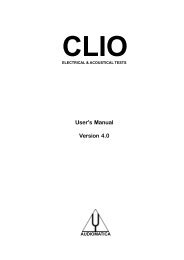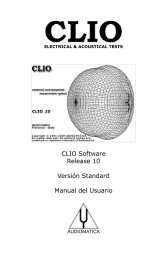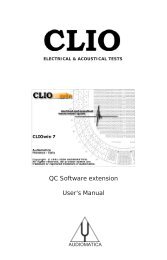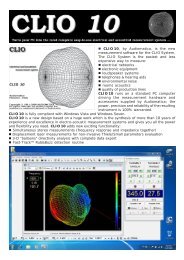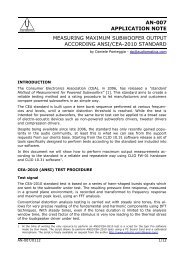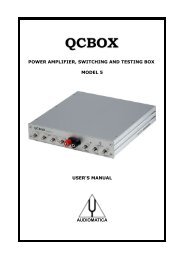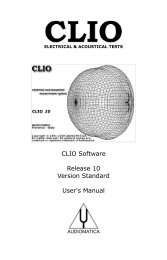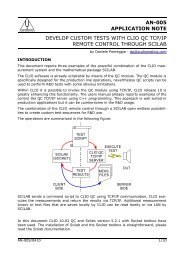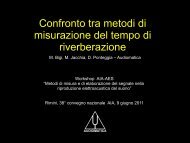CLIOwin 7 PCI User's Manual - Audiomatica
CLIOwin 7 PCI User's Manual - Audiomatica
CLIOwin 7 PCI User's Manual - Audiomatica
Create successful ePaper yourself
Turn your PDF publications into a flip-book with our unique Google optimized e-Paper software.
10.6 PROCESSING TOOLS BY EXAMPLE<br />
CLIO has powerful processing tools that can be helpful in several circumstances. We saw<br />
the basics at the beginning of this chapter. It was just a brief description of the kind "press<br />
this to do that". Here we are going to use some of them in practice. Some general rules<br />
apply to a group of them for four basic operations. You can add, subtract, multiply and<br />
divide the data in memory either with a single complex value or with a compatible file.<br />
Compatible means that it must be a file with the same basic settings as the one in<br />
memory. Y-scale must also be the same that is you cannot add dBV with Ohm. The use<br />
of Load Process and Save Process, will become clearer as we review the examples. The<br />
Add and Sub functions are used mostly among files. We will use them to obtain the sum<br />
and difference of the woofer and tweeter of Fig.10.20. Results are in Fig.10.30 where<br />
the sum is in red and the difference in blue. These are useful plots to start with during<br />
a cross-over design. For example it is interesting to consider the big notch in the sum<br />
curve, something not easy to imagine from the magnitude response.<br />
110.0<br />
CLIO<br />
180.0<br />
dBSPL<br />
Deg<br />
100.0 108.0<br />
90.0 36.0<br />
80.0 -36.0<br />
70.0 -108.0<br />
60.0 -180.0<br />
20 100 1k Hz<br />
10k 20k<br />
Figure 10.30<br />
The divide function, in its most classical use, allows the user to show a magnitude<br />
response as a transfer function with another measurement. Suppose you want to<br />
evaluate how the grid affects the frequency response. We will use the response of<br />
Fig.10.17 as a reference, which has been taken with the grid in place. We remove it,<br />
take another measurement, and perform a division by file with the grid in place. We<br />
remove it, take another measurement, and perform a division by file with the data of<br />
the reference. Result is in Fig.10.31.<br />
20.0<br />
CLIO<br />
180.0<br />
dBRel<br />
Deg<br />
10.0 108.0<br />
0.0 36.0<br />
-10.0 -36.0<br />
-20.0 -108.0<br />
-30.0 -180.0<br />
20 Hz<br />
100 1k 10k 20k<br />
Figure 10.31<br />
Note that the y-scale has been automatically changed to dBRel. This is a good point to<br />
introduce the use of Load and Save process together with the Automatic Processing<br />
Chapter 10 - MLS 125



